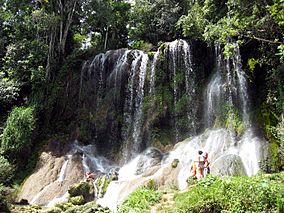Desembarco del Granma National Park facts for kids
Quick facts for kids Desembarco del Granma National Park |
|
|---|---|
|
IUCN Category II (National Park)
|
|

A waterfall in the national park
|
|
| Location | Cuba |
| Nearest city | Niquero |
| Area | 261.80 km² |
| Established | 1986 |
| Type: | Natural |
| Criteria: | vii, viii |
| Designated: | 1999 (23rd session) |
| Reference #: | 889 |
| Region: | Latin America and the Caribbean |
Desembarco del Granma National Park (which means "Landing of the Granma National Park" in Spanish) is a special natural area in southwestern Cuba. It stretches across the towns of Niquero and Pilón in Granma Province.
The park gets its name from an important event in Cuban history. In 1956, a yacht named Granma landed here. On board were Fidel Castro, Che Guevara, Raúl Castro, and 79 other people. They sailed from Mexico to Cuba to start the Cuban Revolution, a big change in the country's government.
This national park is famous for its amazing karst landscape. This means it has unique rock formations, like tall coastal cliffs. In 1999, UNESCO named it a World Heritage Site. This was because of its incredible raised sea terraces and beautiful, untouched sea cliffs. The park covers about 32,576 hectares, with most of it on land and some in the sea.
Exploring the Park's Landscape
Desembarco del Granma National Park is found at the western end of the Sierra Maestra mountains. This area is very active geologically, meaning the Earth's plates are moving here. The park protects a series of limestone terraces. These terraces go from 180 meters below sea level to 360 meters above it.
These terraces likely formed over millions of years. They were created by the Earth's crust slowly lifting up. Changes in sea level from past ice ages also played a part. These terraces are some of the biggest and best-preserved in the world. The park also has many other cool rock features. These include waterfalls, steep cliffs, deep sinkholes, and mysterious caves.
The park has a warm, somewhat dry climate. It gets between 300 and 1200 mm of rain each year. The average temperature is about 26°C (79°F). This makes it one of the warmest and driest spots in Cuba.
Amazing Plants and Animals
This national park is home to many different kinds of plants and animals. Many of these species are found only in Cuba, or even only in this park!
- Plants: More than 512 types of plants grow here. About 60% of them are unique to Cuba. Twelve of these plant species have only ever been found inside this park.
- Snails: The park protects six types of colorful painted snails. These snails are very special and have different family lines.
- Animals: The park is home to 13 types of mammals, 110 kinds of birds, 44 types of reptiles, and 17 kinds of amphibians.
- Over 90% of the amphibians and reptiles found here are unique to Cuba. This includes the Cuban night lizard, which is an endangered species.
- Birds living in the park include the Cuban amazon parrot and the blue-headed quail-dove.
- Mammals you might find are the West Indian manatee (a gentle sea creature) and the Cuban flower bat. This bat is special because it can live in hot caves.
See also
 In Spanish: Parque nacional Desembarco del Granma para niños
In Spanish: Parque nacional Desembarco del Granma para niños
- Niquero, the town where a large part of the national park is located.
- Granma, the famous yacht that landed here with the revolutionaries.


